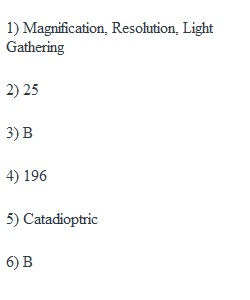


Q Telescopes and Binoculars Assignment: 1. Analyze the following questions 2. Complete all the calculations Here is a Microsoft Word file of the questions - Third hour exercise E.docx Download Third hour exercise E.docx Method and preparations You will need a calculator for today's Third Hour Activity... Watch the helpful videos, complete the calculations, and submit your answers below. Note that in some of the questions, I indicate a range that your answer should fall within. If your answer is out of this range, it is wrong. If your answer is within the range....it MIGHT still be wrong, but it suggests you are on the right track. Helpful videos for Third hour E To turn in your answers for grading, hit the "Submit Assignment" Button in the top right and then submit all the work as text. After the instructions, below, I have a simple form you can use to cut/paste when submitting your answers. Questions 1. After introducing the different common types of telescopes, we discussed three main powers of telescopes. What are they? 2. Look at the binoculars illustrated below, labelled Set A, B, C, and D. What is the highest magnification power of the four sets displayed? (Hint: give the magnification, not the letter for the set.) 3. Of the four sets of binoculars illustrated in this assignments, which set--A, B, C, and D--has the most light gathering power? 4. Assuming your eye has an aperture of approximately 5 mm, what is the light gathering power of binoculars set B, compared to your eye? (Hint: your answer should be somewhere between 180 and 240.) 5. What kind of telescope uses a large lens as the objective to gather light? A reflector, a refractor, or a catadioptric (such as a Cassegrain)? For the following set of questions, suppose you had three telescopes, each with an eyepiece. Telescope A is a catadioptric with an objective diameter of 200 mm, focal length of 2000 mm, and an eyepiece of focal length 10 mm. Telescope B has an objective lens with diameter of 75 mm, focal length of 1200 mm, and an eyepiece of focal length 40 mm. Telescope C has an objective mirror with an aperture of 150 mm, focal length of 750 mm, and eyepiece of focal length 25 mm. 6. Which telescope, A, B, or C, is the refracting telescope? 7. What magnification would you get with telescope B? (Hint: your answer should be somewhere between 15 and 40.) 8. What is the light gathering power of telescope A compared to telescope B? (Hint: your answer should be somewhere between 5 and 10.) 9. What is the light gathering power of telescope B compared to one of the lenses of binoculars set D? (Hint: your answer should be somewhere between 3.5 and 9.) 10. Suppose you were observing with telescope A. What is the maximum practical magnification you would expect from this telescope? (Hint: your answer should be somewhere between 200 and 500.) 11. Suppose you were observing with telescope A, and you had three new eyepieces you were considering using. The focal lengths of the eyepieces are as follows. Eyepiece #1: 15 mm Eyepiece #2: 4 mm Eyepiece #3: 35 mm. Which eyepiece would be a BAD choice for you to use? (Hint: Consider your result from question #10). 12. Consider all four eyepieces that we used for telescope A (35, 15, 10, 4 mm). Which of these would provide the widest field of view? Cutting/pasting the following may help you when you are submitting your answers. 1) 2) 3) 4) 5) 6) 7) 8) 9) 10) 11) 12) PreviousNext
View Related Questions